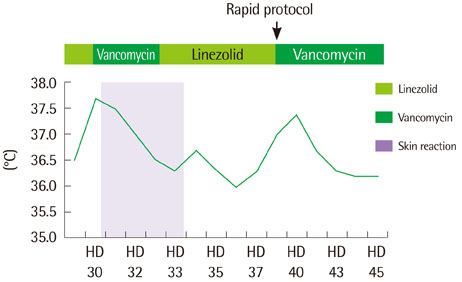Allergy Asthma Respir Dis.
2013 Jun;1(2):168-171. 10.4168/aard.2013.1.2.168.
Successful desensitization for vancomycin hypersensitivity
- Affiliations
-
- 1Department of Internal Medicine, Pusan National University School of Medicine, Busan, Korea. parkhk@pusan.ac.kr
- KMID: 2261866
- DOI: http://doi.org/10.4168/aard.2013.1.2.168
Abstract
- Vancomycin frequently induces hypersensitivity reactions including red man syndrome (RMS) and anaphylaxis. Lowering infusion rate with antihistamine premedication is usually effective to reduce RMS, however, desensitization should be considered for severe reactions not responding to usual measures. Here, we report a case of a patient with pyogenic spondylitis who had developed hypersensitivity reaction to vancomycin, got a full recovery with vancomycin desensitization. A 63-year-old man was transferred to our hospital for back pain, proved to pyogenic spondylitis. As methicillin-resistant Staphylococci aureus infection was suspected, vancomycin was administrated. But, he showed hypersensitivity reactions such as hypotension, dyspnea and severe flushing after vancomycin administration at previous hospital. Readministration of vancomycin at a lower infusion rate with premedication was tried. Three hours after vancomycin infusion, he developed fever, chills, rash and hypotension. Thrombocytopenia was occurred after administration of other antibiotics including cefazolin and teicoplanin. Vancomycin administration was attempted according to a rapid desensitization protocol. The infusion rate of vancomycin was increased to the standard rate. After the desensitization, he successfully completed the full course of treatment with vancomycin. Vancomycin desensitization could be the option for the vancomycin hypersensitivity when other antibiotics are not feasible.
Keyword
MeSH Terms
Figure
Reference
-
1. Kupstaite R, Baranauskaite A, Pileckyte M, Sveikata A, Kadusevicius E, Muckiene G. Severe vancomycin-induced anaphylactic reaction. Medicina (Kaunas). 2010; 46:30–33.2. Simons FE. Anaphylaxis. J Allergy Clin Immunol. 2010; 125:S161–S181.
Article3. Sivagnanam S, Deleu D. Red man syndrome. Crit Care. 2003; 7:119–120.4. Lin RY. Desensitization in the management of vancomycin hypersensitivity. Arch Intern Med. 1990; 150:2197–2198.
Article5. Lerner A, Dwyer JM. Desensitization to vancomycin. Ann Intern Med. 1984; 100:157.
Article6. Wazny LD, Daghigh B. Desensitization protocols for vancomycin hypersensitivity. Ann Pharmacother. 2001; 35:1458–1464.
Article7. Korman TM, Turnidge JD, Grayson ML. Risk factors for adverse cutaneous reactions associated with intravenous vancomycin. J Antimicrob Chemother. 1997; 39:371–381.
Article8. Polk RE, Healy DP, Schwartz LB, Rock DT, Garson ML, Roller K. Vancomycin and the red-man syndrome: pharmacodynamics of histamine release. J Infect Dis. 1988; 157:502–507.
Article9. O'Sullivan TL, Ruffing MJ, Lamp KC, Warbasse LH, Rybak MJ. Prospective evaluation of red man syndrome in patients receiving vancomycin. J Infect Dis. 1993; 168:773–776.10. Wallace MR, Mascola JR, Oldfield EC 3rd. Red man syndrome: incidence, etiology, and prophylaxis. J Infect Dis. 1991; 164:1180–1185.
Article11. Hassaballa H, Mallick N, Orlowski J. Vancomycin anaphylaxis in a patient with vancomycin-induced red man syndrome. Am J Ther. 2000; 7:319–320.
Article12. Renz CL, Laroche D, Thurn JD, Finn HA, Lynch JP, Thisted R, et al. Tryptase levels are not increased during vancomycin-induced anaphylactoid reactions. Anesthesiology. 1998; 89:620–625.
Article13. Anne' S, Middleton E Jr, Reisman RE. Vancomycin anaphylaxis and successful desensitization. Ann Allergy. 1994; 73:402–404.14. Polk RE, Israel D, Wang J, Venitz J, Miller J, Stotka J. XMLLink_XYZ. Antimicrob Agents Chemother. 1993; 37:2139–2143.15. Wilson AP. Comparative safety of teicoplanin and vancomycin. Int J Antimicrob Agents. 1998; 10:143–152.
Article16. Sahai J, Healy DP, Garris R, Berry A, Polk RE. Influence of antihistamine pretreatment on vancomycin-induced red-man syndrome. J Infect Dis. 1989; 160:876–881.
Article17. Kitazawa T, Ota Y, Kada N, Morisawa Y, Yoshida A, Koike K, et al. Successful vancomycin desensitization with a combination of rapid and slow infusion methods. Intern Med. 2006; 45:317–321.
Article
- Full Text Links
- Actions
-
Cited
- CITED
-
- Close
- Share
- Similar articles
-
- Effectiveness of premedication and rapid desensitization in hypersensitivity to L-asparaginase
- Cyclosporine Desensitization in Patient with Multiple Hypersensitivity Reactions Immediately after Peripheral Blood Stem Cell Transplantation
- Rapid desensitization to isoniazid and rifampin in an adolescent with active pulmonary tuberculosis
- Successful desensitization for treatment of an exfoliative dermatitis to allopurinol
- Vancomycin-induced Hypersensitivity Reaction with Slow Infusion : A case report


